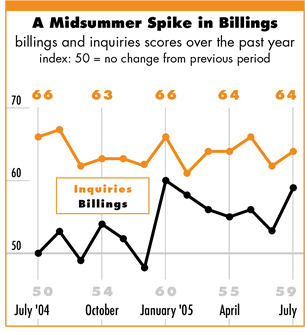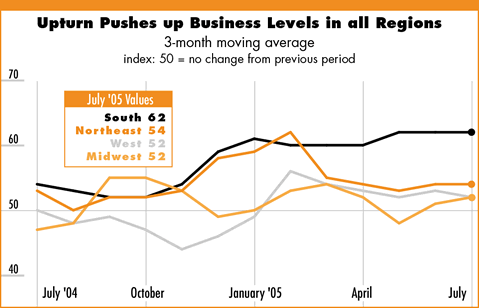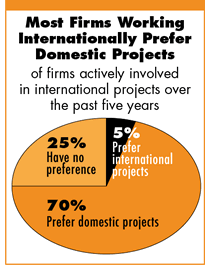

08/2005
Hot Weather Heats Up Firms’ Workloads
International projects small share of the load; not most desired work type

by
Kermit Baker, PhD, Hon. AIA
Chief Economist
 Billings
at architecture firms typically dip a bit in July, but firms reported
strong gains nationally last month as the nonresidential construction
expansion continued to pick up steam. There are no signs of a slowdown
on the horizon. New project inquiries also increased in July. All told,
it is shaping up to be a strong fall for design firms.
Billings
at architecture firms typically dip a bit in July, but firms reported
strong gains nationally last month as the nonresidential construction
expansion continued to pick up steam. There are no signs of a slowdown
on the horizon. New project inquiries also increased in July. All told,
it is shaping up to be a strong fall for design firms.
The upturn in activity has reached the point where firms in all regions are reporting stronger business conditions. Firms in the South are seeing the most growth, but firms in the Northeast and Midwest are reporting an extended upturn in billings. Residential firms continue to see impressive gains in billings, and institutional firms have indicated sustained increases in business levels over the past several months.
Housing starts strong, inflation still generally contained
The positive numbers recorded at architecture firms in recent months
are supported by an improving economy. Despite the Federal Reserve
Board’s steady increase in short-term interest rates, long-term
rates have remained steady, keeping homebuilding strong. Housing starts
totaled 2.04 million homes at a seasonally adjusted and annualized
rate in July, the sixth time in the seven months of 2005 that starts
were over the 2.0 million levels.

The employment numbers continue to be favorable, with more than 1 million net payroll positions added during the first six months of the year, and another 207,000 added in July. Higher prices for gasoline, as well as for other commodities, have driven up the rate of inflation in recent months, but inflation is generally contained to those sectors. Once fluctuations in the volatile fuel and food sectors are removed, consumer prices have risen at a manageable 2.00–2.25 percent rate over the past year, with wholesale prices rising about a half point faster.
August is shaping up as a generally slower month for the economy, according to the preliminary reading for consumer sentiment from the University of Michigan. That indicator has dropped quite sharply in August, after rising slightly in July.
International involvement
at fairly modest levels
Although domestic design markets are expanding nicely, some firms are
pursuing international design opportunities. One in eight firms (12.5
percent) has been actively involved in international projects (built
on foreign soil) over the past five years. Of these firms involved
in projects over the past five years, 60 percent reported some international
billings in 2004. Generally, the share of billings from international
work is fairly small; for most firms it was under 5 percent of total
billings last year, and was above 10 percent of billings for only 16
percent of firms with international billings last year.
 Firms that have
been involved in international projects over the past five years are
more likely to be located in the South or Northeast and more likely
to be larger firms (more than 17 percent of firms with $1 million or
more a year in billings reported international involvement over the past
five years). Commercial/industrial is the specialty of firms most likely
to be working internationally.
Firms that have
been involved in international projects over the past five years are
more likely to be located in the South or Northeast and more likely
to be larger firms (more than 17 percent of firms with $1 million or
more a year in billings reported international involvement over the past
five years). Commercial/industrial is the specialty of firms most likely
to be working internationally.
The small share of billings from international projects may be a reflection of the lack of enthusiasm that firms express for these projects. Although a quarter of firms working internationally have no preference for domestic versus international projects, only 5 percent prefer international projects, while 70 percent generally prefer domestic projects.
Copyright 2005 The American Institute of Architects.
All rights reserved. Home Page ![]()
![]()
